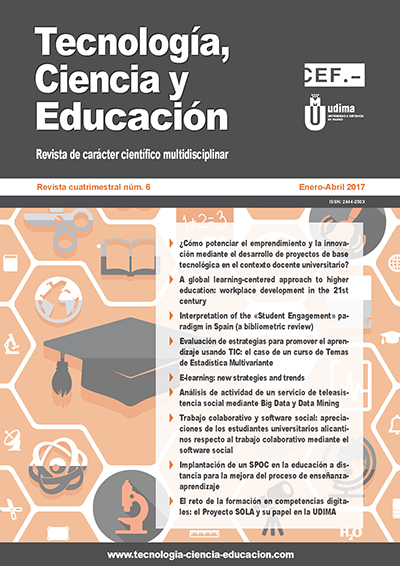How to encourage entrepreneurship and innovation through the development of technology-based projects in the context of university teaching?
DOI:
https://doi.org/10.51302/tce.2017.112Keywords:
entrepreneurship, innovation, Triple Helix Model, entrepreneurial skills, technology-based firms, educational coordinationAbstract
Entrepreneurship and innovation are two of the values demanded by firms today, and therefore the associated skills are enhanced in grades with a clear focus on entrepreneurship. The goal is that students who leave their classrooms were able to undertake and not only in the sense of creating a firm, but also to have the ability to innovate in any tasks that require professional performance. However, despite the clear need to promote entrepreneurship, there are few practical examples of how to teach this competence. In this paper, we present an educational experience based on the theoretical framework provided by the Triple Helix Model, according to which synergies in entrepreneurship are multiplied when are joined the three axes in the task of undertaking: institutional, university and business. Its goal has been to support students from the business idea to the creation of a technology-based company, as a way to enhance their entrepreneurial and innovative capacity. To carry it out has created a multidisciplinary working group in which at university axis level courses of different knowledge domain have been coordinated: engineering, social sciences and humanities.
Downloads
References
Agile Manifesto [2016]: http://agilemanifesto.org/ [Consultado: 3 de mayo de 2016].
Arenius, P. y Minniti, M. [2005]: «Perceptual variables and nascent entrepreneurship», Small Business Economics, 24 (3), págs. 233-247.
Aulet, B. [2015]: La disciplina de emprender, Madrid: LID.
Batista Canino, R. M.; Fernández-Laviada, A.; Medina Brito, M.ª del P.; Esteban Lloret, N. N.; Rueda Sampedro, I. y Sánchez Ruiz, L. [2015]: «Educación en emprendimiento», en I. P. Legazkue, M. Guerrero y J. L. González-Pernía (eds.), Global entrepreneurship monitor: Informe GEM España 2014, 18, Santander: Universidad de Cantabria, págs. 125-145.
Blumenfeld, P. C.; Soloway, E.; Marx, R. W.; Krajcik, J. S.; Guzdial, M. y Palincsar, A. [1991]: «Motivating project-based learning: sustaining the doing, supporting the learning», Educational Psychologist, 26 (3-4), págs. 369-398.
Bologna Process [2016]: http://www.ehea.info [Consultado: 3 de mayo de 2016].
Castillo, H. G. C. [2010]: «El modelo de la triple hélice como un medio para la vinculación entre la universidad y empresa», Revista Nacional de Administración, 1 (1), págs. 85-94.
Clark, B. R. [1998]: Creating entrepreneurial universities: organizational pathways of transformation, Oxford: Pergamon.
Comisión Europea [2006]: Recomendaciones del Parlamento Europeo y del Consejo de 18 de diciembre de 2006 sobre las competencias clave para el aprendizaje permanente (Diario Oficial de la Unión Europea, 30-12-2006).
[2008]: La iniciativa emprendedora en la enseñanza superior, especialmente en estudios no empresariales, Dirección General de Empresa e Industria.
Etzkowitz, H. y Leydesdorff, L. [2000]: «The dynamics of innovation: from National Systems and “Mode 2” to a Triple Helix of university-industry-government relations», Research Policy, 29 (2), págs. 109-123.
Etzkowitz, H. y Ranga, M. [October 2010]: «A Triple Helix System for knowledge-based regional deve-lopment: from “Spheres” to “Spaces”», VIII Triple Helix Conference, Madrid.
Etzkowitz, H.; Webster, A.; Gebhardt, C. y Terra, B. C. R. [2000]: «The future of the university and the university of the future: evolution of ivory tower to entrepreneurial paradigm», Research Policy, 29 (2), págs. 313-330.
Fundación Príncipe de Girona [2011]: Libro blanco de la iniciativa emprendedora en España, Resumen Ejecutivo, FPdGi.
Krueger, N. y Casrud, A. L. [1993]: «Entrepreneurial intentions: applying the theory of planned behavior», Entrepreneurship and Regional Development, 5, págs. 315-330.
Leydesdorff, L.; Dolfsma, W. y Panne, G. van der [2006]: «Measuring the knowledge base of an economy in terms of triple-helix relations among “technology, organization, and territory», Research Policy, 35 (2), págs. 181-199.
McClelland, D.; Atkinson, J.; Clark, R. y Iowell, E. [1953]: The achievement motive, New York: Appleton-Century-Crofts.
Miró, J. y Jaume, A. [2010]: «Repositorio de actividades para enseñar competencias transversales», REDU. Revista de Docencia Universitaria, 8 (1), págs. 101-110.
Peterman, N. E. y Kennedy, J. [2003]: «Enterprise education: influencing students’ perceptions of entrepreneurship», Entrepreneurship Theory and Practice, 28 (2), págs. 129-144.
Pittaway, L. y Cope, J. [2007]: «Entrepreneurship education a systematic review of the evidence», International Small Business Journal, 25 (5), págs. 479- 510.
Schwaber, K. [2004]: Agile project management with Scrum, Redmond (Washington): Microsoft Press.
Scrum Manager [2016]: https://www.scrumalliance.org/community/articles/2014/august/agilegamification [Consultado: 3 de mayo de 2016].
Shane, S. A. [2004]: Academic entrepreneurship: university spinoffs and wealth creation, United Kingdom: Edward Elgar Publishing.
Viale, R. y Etzkowitz, H. [2005]: «Third academic revolution: polyvalent knowledge; the DNA of the triple helix», Fifth Triple Helix Conference, págs. 18-21.
Wagenaar, R. (ed.) [2003]: Tuning educational structures in Europe. Final report. Phase one, Bilbao: University of Deusto.
Downloads
Published
How to Cite
Issue
Section
License
Copyright (c) 2017 Mercedes Segarra Ciprés, Reyes Grangel Seguer, Óscar Belmonte Fernández, Sergio Aguado González

This work is licensed under a Creative Commons Attribution-NonCommercial-NoDerivatives 4.0 International License.


























